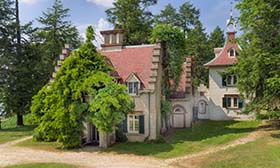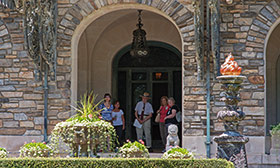Historic Hudson Valley is a not-for-profit education organization that interprets and promotes historic landmarks of national significance in the Hudson Valley for the benefit and enjoyment of the public.
In support of our educational mission, Historic Hudson Valley welcomes more than 250,000 visitors annually to its network of historic sites and special events. We reach tens of thousands more through digital programs and off-site school programs.
Historic Hudson Valley owns, restores, and preserves several sites that possess documented historical integrity, architectural distinction, superb decorative and fine arts collections, and exceptional importance of landscape and setting. Together, these sites provide meaning for visitors in a variety of settings, including traditional house and landscape tours, formal educational programs for schoolchildren, popular on-site special events, and digital media.
Our Story
Founded in 1951 as Sleepy Hollow Restorations by John D. Rockefeller, Jr., Historic Hudson Valley is a 501(c)(3) organization chartered by the New York State Department of Education and the largest non-profit cultural organization in Westchester County.
We focus on delivering quality educational and entertaining experiences, striking a balance between tradition and vision, from preserving the past, to contextualizing it for 21st-century audiences.
Rooted in tradition, we continue to evolve and embrace future opportunities. The Historic Hudson Valley of today is more collaborative, creative, and entrepreneurial than ever before, aptly reflecting the spirit of its founder.
Our Mission
To celebrate the history, architecture, landscape, and culture of the Hudson Valley, advancing its importance and thereby assuring its preservation.
In order to achieve its educational mission, Historic Hudson Valley seeks:
- To interpret Hudson Valley history and culture with meticulous attention to accuracy based on thorough research.
- To present its educational material in the context of the region’s key humanities themes.
- To create visitor-centric programming that responds to the public’s evolving interests and varied learning styles.
- To link popular public programs to historic sites, themes, and characters.
- To convey interpretive content through interactive, digital means, to both on-site and off-site audiences.
- To make programs and sites accessible and welcoming to all members of the community.
- To maintain the highest standards of preservation management.
- To enhance and safeguard its intellectual and physical collections through on-going research, documentation, and conservation.
- To augment internal resources with external inspiration.
- To forge mutually beneficial alliances with like-minded organizations.











